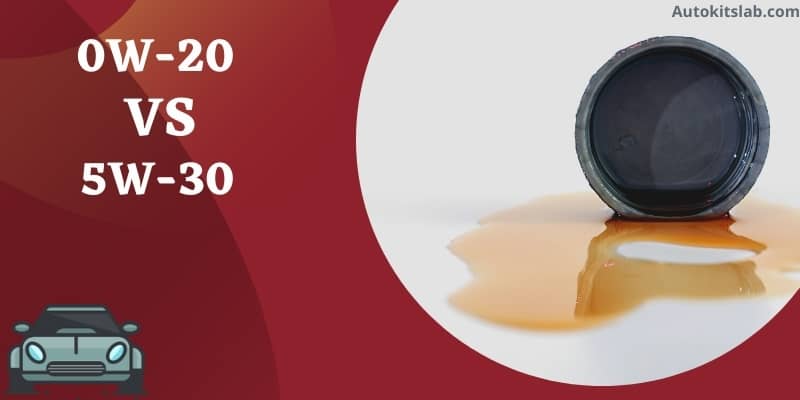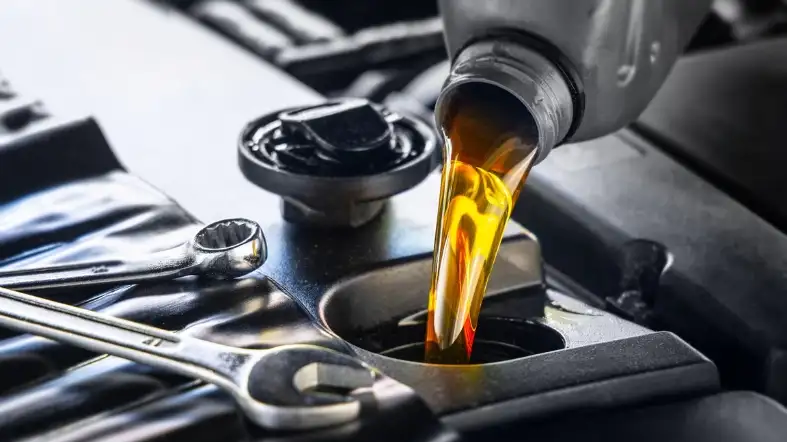Different types of oils are available in the market for different kinds of vehicles.
There are 11 types of oil 0W-20, and 5W-30 is the most common and popular because of their fuel economy performance.
When you observe these two types of oil’s performance, both look the same. 0W-20 and 5W-30 both oils are designed for low-temperature usage and ensure your vehicle’s maximum efficiency.
Though they both are the right choice for cold weather, there has a debate about 0W-20 vs 5W-30, which is better.
If you have no idea about it or have a little bit, then nothing to worry about! This article describes every ins and outs of viscosity, oil change, and many more things. Just stick to our article.

0W-20 VS 5W-30: Know Everything Now
What is Oil Viscosity?
In simple words, oil viscosity means how the oil is flowing at a particular temperature.
As oil is a liquid component and there is a freezing tendency in low temperatures. So at a low temperature, the thin oil can flow more easily than the thick oil.
And oil viscosity refers to this oil’s fluid tendency.
At low-temperature thin oil protects your vehicle’s engine by maintaining less metal friction.109 years ago (1911), the (SAE) society of automotive engineers formed this oil grading code depending on the oil’s viscosity levels.
Grade Wise Oil Explanation
Oil viscosity has two grades one is single grade oil, and another is multiple grade oil.
Single grade oil has 11 types, which we have mentioned in the introduction of our article.
From these 11 types, 6 oil grades are for low temperature, and 5 grades are for high temperature.
The low-temperature grades are respectively 0W, 5W, 10W, 15W, 20W, and 25W. The high-temperature grades are respectively 20, 30, 40, 50, and 60.
Some Necessary Information About 0w-20 Oil vs 5W-30

People mostly know 0w-20 oil as a low viscosity oil. Here 0 means 0 levels of oil flow, W means winter, and 20 means viscosity level or thinness of oil in hot weather according to (SAE).
In the winter season, the viscosity decreases, and in summer, viscosity increases. Using 0w-20 Oil in winter is winter than 5W-30.
When we talk about 5W-30 oil here, 5 means the level of oil flow under 5 degrees Celsius, W means winter, and 30 means viscosity level or thickness of oil at extremely cold or excessively hot weather.
Fuel cost of 0W20 vs 5W20
The 0W20 and 5W20 oil are the right choices for you if you live in a low-temperature state.
Both of the oils provide you maximum efficiency of oil consumption and less amount of exhaust smoke.
All the feature’s consequences are enhanced engine life and lower fuel cost. How excellent! A win from two sides.
Europe, Japan, and the USA are in a low-temperature state. And both the oils are playing a leading role there in the automobile oil industry section.
If you use the 0W20 and 5W20 oils in these particular cold-weather states, you can’t figure out any differences between them.
How to Determine You Have to Use 0W20 or 5W20 Oil?

Yes, it’s a typical but very crucial question. You have to know how you can determine which oil you have to use in which situation. Some determining factors are
1. Notice Your Vehicle’s User Manual
When you have bought a vehicle from a manufacturer company, they provide you a user manual with the car.
There you will find all information about the vehicle. So primarily, notice your vehicle’s manual to know which oil they recommend to use.
You have to use the manufacturer’s recommended oil to get the highest performance from your car.
If they recommend both of the 0W20 and 5W20 oils, then you can use one after another according to the outside temperature.
2. Your Driving Area
You can use both the oils in mostly the same weather condition. Already you have come to know the temperature limit of these two grades of oil from our table.
So if you drive the vehicle within -40 degrees Celsius to 20 degrees Celsius, it is better to use 0W20 grade oil.
And if you drive the car within -35 degrees Celsius to 20 degrees Celsius, it is better to use 5W30 grade oil.
3. Viscosity Level
The smaller number represents the thinner oil, and the thinner oil represents better oil flow in cold weather.
In this case, 0W-20 performs better than 5W-30 oil. Starting the 0W-20 ensures more oil flow, but the 5W-30 is the better performer in standard engine operation.
4. Test Oil Quality
The American Petroleum Institute or (API) and Special Synthetic Lubricants SL test the oil quality.
If the oil passes the SL service, it shows the starburst symbol, and if the oil passes the API test, it shows the API donut.
5. Fuel Economy
After considering all those things, it’s time to look at your wallet. You have to use that oil, which provides you maximum efficiency by saving some bucks.
If both 0W20 and 5W20 oils fit your vehicle, you should use the less expensive synthetic oil.
Blends of Motor Oil

There are four blends of motor oil. Let’s have a look at those blends.
- Conventional Premium Oil:
Conventional oils are mineral and accurate for a brand new car with a simply designed engine and a light-duty operating system. This oil is available in various grades of viscosity.
- Fully synthetic motor oil:
Full synthetic oils ensure high performance in any highly technical engine like the 3.5 Ecoboost engine. Since this oil is fully synthetic, that’s why it lubricates all the engine-related parts to improve deposits, metal friction, and dust.
This oil is slightly expensive as it enhances your vehicle’s engine lifespan. The AmazonBasics 5W-30 and the Valvoline 5W-20 are two types of the most popular full synthetic motor oil.
- Semi-synthetic or blend synthetic oil:
Semi-synthetic oil means there is a mixture of synthetic oil and organic oil. Though this oil is not as slippery as synthetic oil, it decreases oil usage and increases the oil economy.
These blends of oils are used as a fuel source for SUVs, cars, Jeeps, and many other pick-ups and trucks. Some of the popular 5W-30 synthetic blends oils are Motorcraft SAE, Mobil 1(112799), etc.
- High mileage motor oil:
The number four blends of oil are high mileage motor oil. These vehicles can run 75000-150000 miles according to the odometer. The high mileage oils have a sealing conditioner, and they are flexible.
The high mileage oils improve viscosity to protect the engine’s wear and deposits. The Castrol 06440 GTX and Havoline 5W-30 are two popular high mileage oils that you can use for your vehicle’s fuel source.
Some Frequently Asked Questions:
Oils work in a way as blood works to your body. Without blood, you can’t live, and without oil, an engine can’t run.
People like you who have different kinds of vehicles want to know some essential information about the engine’s oil. We hope these questions answer make interest to you.
Can you mix 0W-20 and 5W-20?
If you can use one brand of oil, then you have to avoid oil mixed up. The 0W-20 is the most thinner and synthetic oil, while 5W-20 is organic oil.
So they can’t mix correctly. If you mix them up, they will fail to operate at -35° Celsius. Even it arises with various problems of oil efficiency.
Can I use 5w-30 instead of 0w-20?
One word answer is no. The 5w-30 oil is fully synthetic and high mileage oil, having a superb flow when driving the car.
Toyota and many other companies recommend 5w-30 oil for the long-lasting engine. Using 0w-20 oil reduces the engine’s longevity.
Can I switch one brand of oil to another brand?
Yes, you can. But before changing the oil brand, don’t forget to check out the oil viscosity.
Because using wrong oil’s viscosity randomly makes cold start problem, increase engine noise, decrease diving efficiency, and ruin your engine’s life
Wrap Up
As oil’s working is invisible, that doesn’t mean you don’t have to pay attention while choosing oil for your vehicle.
Rather you have to pay 110% attention instead of 100% attention. We think after spending two minutes of your valuable time reading this article, you can know everything about 0W-20 vs 5W-30 oil.
So next time, which oil do you pick for your vehicle? Let us know by commenting on the comment box.
